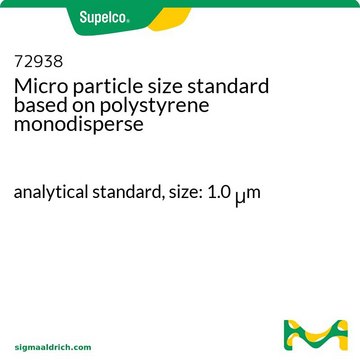95531
Micropartikel Grössenstandard auf Polystyrolbasis monodispers
analytical standard, size: 30.0 μm
Synonym(e):
Grössenstandards
Anmeldenzur Ansicht organisationsspezifischer und vertraglich vereinbarter Preise
Alle Fotos(1)
About This Item
Empfohlene Produkte
Qualität
analytical standard
Qualitätsniveau
Form
aqueous suspension
particles
Quervernetzung
2 % cross-linked
Konzentration
2% (solids)
Partikelgröße
30.0 μm std dev <0.5 μm, coeff var <2%
Anwendung(en)
glass & ceramic
industrial qc
pharmaceutical
Format
neat
Lagertemp.
2-8°C
Suchen Sie nach ähnlichen Produkten? Aufrufen Leitfaden zum Produktvergleich
Verwandte Kategorien
Allgemeine Beschreibung
Monodisperse polystyrene based micro particles (size: 30 μm) are a particle size standard, ideal for characterizing particle size distribution (PSD) of test samples.
Anwendung
Used to calibrate and validate the performance of particle size analyzers.
Monodisperse polystyrene latex particles can also be used to:
Monodisperse polystyrene latex particles can also be used to:
- validate the Airy Disc First Fringe (ADFF) analysis technique based on size measurements
- study the size effect of polystyrene microplastics on the sorption of organic contaminants
Leistungsmerkmale und Vorteile
- suitable for routine instrument calibration checks, testing and corrections
- available in 5 mL pack size as a neat sample
Hinweis zur Analyse
Für jede Charge werden genaue Werte der Partikelgröße und Standardabweichung mit einer Genauigkeit von 0,001 μm ermittelt. Die Größenbestimmung dieser Partikel befolgt die vom National Institute of Standards and Technology (NIST, USA) bzw. die vom Community Bureau of Reference (BCR) vorgeschriebenen Verfahren, insbes.:
- Transmissionselektronenmikroskopie (TEM)
- Rasterelektronenmikroskopie
- Lichtmikroskopie
- Coulter™ Zähler mit MDF-System
Rechtliche Hinweise
Coulter is a trademark of Beckman Coulter, Inc.
Lagerklassenschlüssel
10 - Combustible liquids
WGK
WGK 3
Flammpunkt (°F)
410.0 °F
Flammpunkt (°C)
210 °C
Persönliche Schutzausrüstung
Eyeshields, Gloves
Hier finden Sie alle aktuellen Versionen:
Besitzen Sie dieses Produkt bereits?
In der Dokumentenbibliothek finden Sie die Dokumentation zu den Produkten, die Sie kürzlich erworben haben.
Kunden haben sich ebenfalls angesehen
Shimpei Ishiyama et al.
Current biology : CB, 29(19), 3153-3164 (2019-10-01)
The relationship between tickling, sensation, and laughter is complex. Tickling or its mere anticipation makes us laugh, but not when we self-tickle. We previously showed rat somatosensory cortex drives tickling-evoked vocalizations and now investigated self-tickle suppression and tickle anticipation. We
Antoine D Madar et al.
Scientific reports, 9(1), 5282-5282 (2019-03-29)
Pattern separation is a process that minimizes overlap between patterns of neuronal activity representing similar experiences. Theoretical work suggests that the dentate gyrus (DG) performs this role for memory processing but a direct demonstration is lacking. One limitation is the
Taketoshi Sugimura et al.
Neuroscience research, 120, 36-44 (2017-03-13)
Manipulation of visual experience can considerably modify visual responses of visual cortical neurons even in adulthood in the mouse, although the modification is less profound than that observed during the critical period. Our previous studies demonstrated that low-frequency (2Hz) stimulation
Paulina M Getsy et al.
Respiratory physiology & neurobiology, 269, 103250-103250 (2019-07-29)
Acute Lung Injury (ALI) alters pulmonary reflex responses, in part due to changes in modulation within the lung and airway neuronal control networks. We hypothesized that synaptic efficacy of nucleus tractus solitarii (nTS) neurons, receiving input from lung, airway, and
Sarah H Hayes et al.
Progress in neurobiology, 196, 101893-101893 (2020-08-14)
Various theories and their associated mechanisms have been proposed as the neural basis of phantom sound perception (tinnitus), including central gain enhancement and altered cortical oscillations. However, it remains unknown whether these cortical changes directly cause tinnitus, or simply coexist
Unser Team von Wissenschaftlern verfügt über Erfahrung in allen Forschungsbereichen einschließlich Life Science, Materialwissenschaften, chemischer Synthese, Chromatographie, Analytik und vielen mehr..
Setzen Sie sich mit dem technischen Dienst in Verbindung.












